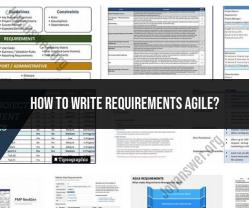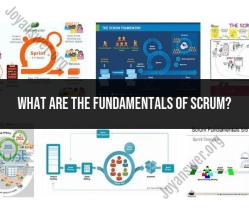How to write requirements agile?
Writing Agile requirements involves a different approach compared to traditional, detailed, and extensive requirements documents. Agile requirements are often referred to as "user stories" and are typically concise, focused on customer value, and subject to change as the project progresses. Here are best practices and strategies for writing Agile requirements:
Use User Stories:
- Agile requirements are commonly expressed as user stories. A user story follows a simple template: "As a [user type], I want [an action] so that [benefit/value]." For example, "As a customer, I want to add products to my shopping cart so that I can purchase them."
Focus on Customer Value:
- Prioritize user stories based on customer value. Ensure that each user story provides clear value to the end-users or stakeholders.
Keep Them Small:
- User stories should be small enough to complete within one iteration or Sprint. This ensures that they are manageable and can be delivered quickly.
Independent and Testable:
- Ensure that each user story is independent and can be tested in isolation. Avoid dependencies between stories whenever possible.
Include Acceptance Criteria:
- Define clear acceptance criteria for each user story. Acceptance criteria outline the conditions that must be met for the story to be considered complete.
Negotiate Details Just in Time:
- Agile encourages delaying detailed discussions until they are needed. You don't need to define every detail upfront; instead, engage in conversations when the story is selected for a Sprint.
Collaborate with Stakeholders:
- Engage in ongoing discussions with stakeholders, including product owners, customers, and developers, to refine and clarify user stories.
Use INVEST Criteria:
- Evaluate user stories against the INVEST criteria to ensure they are well-formed:
- Independent: Stories should not depend on each other.
- Negotiable: They should be open to discussion and refinement.
- Valuable: Stories should deliver value to the customer.
- Estimable: Teams should be able to estimate the effort required.
- Small: Stories should be small and manageable.
- Testable: There should be clear acceptance criteria for testing.
- Evaluate user stories against the INVEST criteria to ensure they are well-formed:
Visualize and Prioritize:
- Use techniques like a product backlog to visualize and prioritize user stories. The backlog should be dynamic and adaptable.
Iteratively Refine:
- Continuously refine user stories as the project progresses. As you learn more and gather feedback, you can improve and adjust the requirements.
Embrace Change:
- Agile projects expect requirements to change over time. Be flexible and embrace changes that bring more value to the product.
Leverage User Personas:
- Create user personas to represent different user types or roles. This helps in understanding user needs and framing user stories effectively.
Include Non-Functional Requirements:
- While user stories typically focus on functional requirements, consider including non-functional requirements (e.g., performance, security, scalability) as part of your user stories or as separate stories when relevant.
Use Story Maps or Story Slicing:
- Story mapping and story slicing techniques can help organize and break down larger features into smaller, manageable user stories.
Keep Documentation Lightweight:
- Avoid extensive documentation. Instead, rely on face-to-face communication, conversations, and collaboration as the primary means of conveying requirements.
Validate with End-Users:
- Whenever possible, involve end-users or stakeholders in validating user stories to ensure they meet their needs and expectations.
Maintain Traceability:
- Keep track of how user stories relate to higher-level project goals and objectives. Maintain traceability between user stories, features, and the overall product vision.
Writing Agile requirements requires a shift in mindset, focusing on delivering value incrementally, embracing change, and fostering collaboration among team members and stakeholders. By following these best practices and strategies, Agile teams can effectively capture and manage requirements while remaining adaptable to evolving customer needs.




